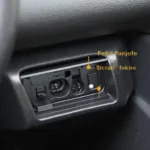The 2010 Hyundai Elantra, like all gasoline-powered vehicles sold in the United States after January 1, 1996, uses the OBD2 standard for its onboard diagnostics system. This means that if you’re looking to diagnose an engine light or check for other potential issues with your 2010 Elantra, you’ll need an OBD2 scanner.
Understanding OBD and OBD2
OBD stands for On-Board Diagnostics. It refers to a vehicle’s self-diagnostic and reporting capability. OBD systems monitor various aspects of your engine and emissions control systems. When they detect a problem, they trigger the check engine light on your dashboard and store a corresponding trouble code within the car’s computer.
OBD2 is the second generation of this technology. Introduced in 1996, it brought standardization to how vehicles communicate with diagnostic equipment. This universal standard means that a single OBD2 scanner can be used to read codes across different makes and models of vehicles.
How to Use an OBD2 Scanner on Your 2010 Hyundai Elantra
Using an OBD2 scanner is a relatively straightforward process:
- Locate the OBD2 port: In most 2010 Hyundai Elantras, the port is located under the dashboard on the driver’s side, near the steering column.
- Plug in the OBD2 scanner: Insert the scanner’s connector into the OBD2 port.
- Turn on the ignition: Turn your key to the “on” position, but don’t start the engine.
- Read the codes: The scanner will power on and communicate with your car’s computer. It will then display any stored trouble codes.
- Research the codes: Use a reliable online resource or the scanner’s manual to understand what each code means.
- Address the issue: Based on the code information, you can either attempt to fix the problem yourself or take your Elantra to a trusted mechanic for professional diagnosis and repair.
Benefits of Owning an OBD2 Scanner
While you can take your car to a mechanic to have the codes read, owning your own OBD2 scanner offers several advantages:
- Save money on diagnostic fees: Mechanics often charge for code reading, which can add up over time.
- Diagnose problems early: Catching issues early can prevent more serious and costly repairs down the road.
- Gain a better understanding of your car: Regularly checking your car’s system with an OBD2 scanner can help you learn more about its overall health and maintenance needs.
“As a mechanic, I always recommend that car owners, especially those with older models like the 2010 Elantra, invest in a good quality OBD2 scanner. It’s a valuable tool for staying on top of your car’s health and can save you money in the long run.” – John Miller, Certified Automotive Technician
Choosing the Right OBD2 Scanner
There are many OBD2 scanners on the market, ranging from basic code readers to advanced professional-grade models. When choosing a scanner for your 2010 Hyundai Elantra, consider the following:
- Basic code readers: These are the most affordable option and are suitable for reading and clearing basic engine codes.
- Enhanced code readers: These offer more features, such as the ability to view live data streams from the car’s sensors.
- Professional-grade scanners: These are the most expensive but offer the most comprehensive diagnostic capabilities, making them ideal for professional mechanics.
In Conclusion
The 2010 Hyundai Elantra uses the OBD2 standard for its onboard diagnostics. Owning an OBD2 scanner empowers you to take control of your car’s maintenance, diagnose problems early, and potentially save money on repairs.
Need assistance choosing the right OBD2 scanner for your Hyundai Elantra? Contact our team via WhatsApp at +1(641)206-8880 or email us at [email protected]. We offer 24/7 customer support to help you find the perfect diagnostic tool for your needs.


